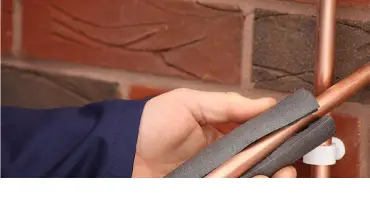
When water freezes inside a pipe, the ice expands and can cause the pipe to burst. The burst pipe can lead to fast and furious flooding on your property. If you’ve ever had a pipe burst during the frigid months, you understand why it’s imperative to avoid freezing pipes this and every winter.
Insulating pipes lowers their exposure to the elements, reducing the chance of disaster while saving you money on energy costs by preventing hot water pipes from losing their heat.
Which Pipes Need Insulation?
Most homeowners will assume that they only need outside water line insulation for pipes and faucets outside the home. But the truth is, any pipe in your home that is exposed and not well insulated, such as those in unheated spaces like exterior walls, garages, attics, basements, and the floor cavities above unheated crawl spaces, will also benefit from insulation.
Insulation Methods and Materials
Here’s a list of materials you may need to complete your pipe insulation project, depending on which kinds of pipes you’re covering:
- Duct tape
- Expanding spray foam
- Foam caulk rope
- Insulation of choice (pipe sleeve, pipe wrap, outdoor faucet cover)
Foam Pipe Sleeves
One of the easiest of all insulation methods is using foam pipe sleeves. We recommend this option for longer, straight pipes that need to be covered. Most sleeves are available in increments of six feet and range in diameter, depending on the pipe size.
To install a foam pipe sleeve over a pipe:
- Position the sleeve along the pipe.
- Open the sleeve slit and cover the pipe.
- Seal the seam with the provided adhesive or duct tape.
- Cut the sleeve to fit the length of the pipe.
Pipe-wrap Insulation
Pipe wrap is simple to install and recommended for insulating small lengths of pipe. It comes in various materials, including flexible foam with rubber backing tape, foam-and-foil pipe insulation tape, bubble-film pipe wrap, foil-backed natural cotton wrap, and rubber pipe insulation tape.
To install pipe-wrap insulation tape on a pipe:
- Attach the loose end of the insulating wrap on one end of the pipe.
- Wrap it around the pipe in spiraling loops, making sure to cover the entire pipe.
- Cut the end off once sufficient insulating wrap is in place.
Outdoor Faucet Covers
A hard foam faucet cover is a simple way to protect outdoor faucets from freezing temperatures and falling ice chunks from your roof and eaves. Most hardware stores sell faucet covers, or you can order them online.
Here’s how to install your faucet cover:
- First, detach your hose from the faucet and put it in a safe spot for the winter.
- Place the rubber loop around the spigot.
- Position the cover over the spigot.
- Tighten the slide lock to hold the cover in place. Make sure there are no air gaps.
Additional Winter Pipe Protection Tips
No matter what type of pipe insulation you choose, keep an eye on your pipes during the winter months. If possible, stop the water flow to outdoor faucets and open the spigots to drain the pipes before the first hard freeze. If you can’t turn off the outdoor water supply, run your spigots occasionally through the winter to double-check and make sure the water pressure is normal.
Count on Mr. Rooter Plumbing for All Your Pipe Repair Needs
If you waited too long and need fast help with a burst pipe, contact your local Mr. Rooter® Plumbing.

